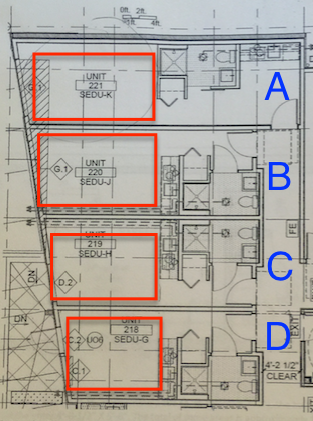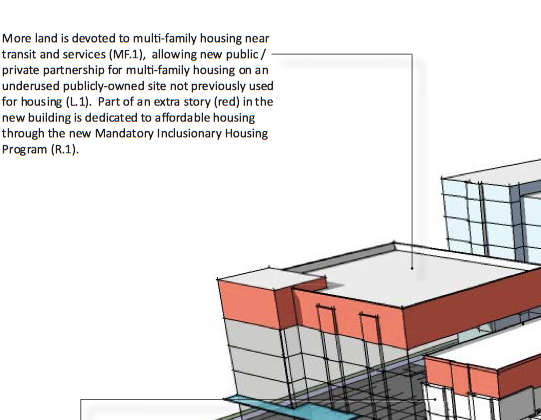Money and Housing: “We’ve Got to Stick Together!”
Well, another Christmas Day has come and gone. For me, as an Anglo-Catholic, yesterday was only the first day of a twelve day celebration that culminates with Epiphany, the celebration of the arrival of the three wise men in Bethlehem. One of the best American movies of all time is It’s A Wonderful Life. The film has always been considered a Christmas movie. I’d argue it’s a move about housing and economics as well as basic principles of what, for lack of anything more sophisticated, goodness looks like in a market economy. I’ve chosen this clip because I’ve had to call upon it time and time again to explain money and housing, something that, in our search for bad guys and villains to blame for our problems, either seems complicated or is deliberately muddled for partisan purposes. We need banks. We need financing. And as one wise man, Sal Kahn creator of the Kahn Academy explains, expanding the supply of money through financing creates more opportunities.
When it comes down to it, housing financing is pretty simple. People need housing, builders can build it, and lenders can invest in housing on behalf of their depositors and create a good return for them. I wish I could go down to City Hall and explain to City staffers busily creating a taxing scheme for new housing or to the Tenants Union or to the Wallingford or Eastlake Community Council and say, like Jimmy Stewart,
You’re thinking about this place all wrong as if I have the money back in a safe!
Stewart’s character, the indefatigable George Bailey goes on to describe the fractional reserve economy. The whole relationship of financing is a balance of trust and faith between people. Sure there are agreements, and instruments, and all sorts of rules and regulations and diligence, but in the end it’s about people taking a risk on some other people. And in turn, people who build and operate housing take a risk on the consumers of housing. When that trust and faith breaks down because we’re trying to find the bad guys making housing expensive, the system collapses.
I kind of see Seattle’s general population today as the mob that shows up at the Building and Loan; scared, worried about the future, and worried about their investment. They want answers and solutions now, and like Tom they’d rather get half than nothing. And their worry and concern is legitimate. A lot is at stake as our city grows. Things change, and there are no guarantees that it’s going to all be wonderful. But George Bailey doesn’t give up or give in. Instead, Jimmy Stewart’s character explains as best he can, then he calls on people to “stick together” against their fears. The Building and Loan is saved, and later, so is George.
Someday, maybe, I’d like to name an institute in the name of Miss Davis, the woman who asks for exactly $17.50. What makes her request worthy of a kiss from George is that it’s expression of genuine need, not, like Tom, a desire to “close the account.” We need more people like Miss Davis, and leaders like George Bailey. George Bailey genuinely cares and is willing to fight for what is right no matter what. Imagine a Mayor and Council that could talk the mob down like George, rather than stoking their fears and handing them someone else’s cash. And Miss Davis knows there’s trouble, but she’s not asking for the moon, just $17.50. As long as it’s Christmas, a time of hope, I’d say that someday I hope we’ll get fewer Toms and more Miss Davis’ in the discussions about our housing needs. We just need to have some faith in one another.
California Housing Forum: “Build More Housing”
I was honored to be a part of an all star set of panels at a forum hosted by the California Apartment Association (CAA) in October. You can download a copy of the report on the CAA website and read more about the conclusions of the forum at my post today at Forbes. And here is a quick highlight video with some of the most relevant comments made at the forum. (Photo and video credit: CAA)
What’s Happening at the Habitability Committee?
The battle over microhousing ended in Seattle with the forces opposed to small, congregate living winning almost completely. The most affordable approach to microhousing included small rooms including a bathroom, a sink, a refrigerator, and a microwave, clustered around a shared kitchen forming a unit. This model of microhousing provided great location, lower overall monthly rent, a greater number of units, and lower costs to build. The Council compromised with opponents (who’d have rather seen a mandate for bigger units with parking), replacing congregate microhousing with units with kitchens and a minimum size of 220 square feet. David Neiman details the progression of how the rules have forced bigger, more expensive units. But what happens as units get smaller, the land use code starts to conflict with the building code making minimum sized units harder to achieve. A sub committee of the Construction Code Advisory Board, the City board that presides over the building code has been taking a look at this conflict.
The easiest way to call out the conflict of inches and feet that ends up pushing up the size of units is with a visualization of 4 small apartment units.
To start with, the building code requires that units (which I’ve labeled from top to bottom A through D) have a minimum space for living that is 150 square feet within the overall 220 SF. I called out, roughly, the living spaces in each of the units. All sorts of things eliminate square feet counting toward the 150 SF minimum, like built in closets, kitchen surfaces, and hallways. Because there is a slight curve to the building to include decks on the bottom two units, the space in those units gets constrained. Here’s what the livable area in each building looks like:
| Unit | Living Space (SF) | Compliant with Unit Minimum | Compliant with Building Code |
| A | 162 | Yes | Yes |
| B | 152 | Yes | Yes |
| C | 134 | Yes | No |
| D | 115 | Yes | No |
The question before the committee is are the last two units “habitable” and “livable.” The City’s Building Code presumes that a space falls beneath habitability when it doesn’t have 150 SF of living space. The argument is that once the living space becomes too small, there isn’t relief from having to move things around to get in and out of the unit and there may not be a place to sit, lie down, or eat meals.
On the other hand, there are other spaces in the units C and D including the hallways and the decks. But those don’t count toward the total. And is there something that happens when a units living space as determined by the building code falls to 149 SF or 115 SF? Some of us on the committee feel like the last two units are perfectly fine, and, when you include the deck space, are just about the same, in the end, as the other two units.
The challenge is where does that slide toward smaller and smaller stop? And our argument back is when does the push to make units bigger and bigger stop? One solution would be allow some percentage of the currently non-allowable space to be added into the 150 SF, so things like hallways or decks might keep the living space total at 150 SF. That means there wouldn’t be a lowering of the requirement, just a different way of calculating it.
In the end, we’ve been making the case that the Council’s intention was units of 220 SF, and as units get that small, it puts pressure on projects to meet that requirement as well as the 150 SF requirement too. It’s not surprising, since various uses take up space, and those uses (like a bathroom or a closet) aren’t necessarily lived in. But some compromise is needed, otherwise the incentive to distort design to meet both will mean fewer, bigger, and more expensive units. The committee is considering survey responses and other aspects and is hoping to make a recommendation by early February.
Take Away Housing Trust Fund Dollars to Punish Seattle’s Intransigence on Housing
Recently I spotted an article about California State Senator Scott Wiener’s proposed legislation that would both relax regulation and impose penalties on local cities that were not allowing more housing to be built. It’s time to consider similar legislation here, especially taking away Housing Trust Fund (HTF) dollars until Seattle backs down from it’s disastrous policy of Mandatory Inclusionary Zoning (MIZ). From the California story:
Details of Wiener’s proposal are still being crafted, but in general it has two prongs: The first is based on legislation he successfully pushed in San Francisco, and would exempt 100 percent affordable housing developments around the state from some local development requirements. The second part would punish cities that don’t meet their building goals, which are set through a state process. The bill calls for the streamlining of developments in cities that don’t meet those goals — essentially, builders would be able to skip some local requirements if they are constructing homes in places that haven’t built aggressively enough.
I’m not going to delve too deeply into California’s legal structure, but I will say that I’ve been hearing more and more frustration among advocates for more housing supply about Seattle’s inability to both pare back rules and regulations that stifle more housing while at the same time imposing even more rules that will just drive up the costs of housing.
In the first case is the all too familiar but bizarre recent Hearing Examiner decision that unplugged a modest City proposal to make it easier to build Detached Accessory Dwelling Units (DADUs). The failure of the City to deliver on DADUs is familiar because it’s a discussion that is more than a decade old. Way back in the early part of the last decade it was decided to experiment with allowing DADUs in Seattle, but it was a rather timid effort that limited the relaxation of rules to just one sixth of the city. Later the Council expanded the DADU program citywide but at a limit of 50 units. Now, DADUs are allowed but difficult to finance, and so not many are happening. The Council didn’t pass legislation that changed subdivision rules and residency requirements that would have fixed this even though they were advised by successful cities like Portland, that this is what is needed.
Second, I’ve been over it a million times: MIZ is infeasible, and when it is feasible it is inflationary, causing all housing prices to rise to fund a small number of expensive subsidized units. This scheme is also plainly illegal. Yet the City grinds forward with it’s effort, using measures that both show plainly the infeasibility of their proposal while also adding higher fees in so called, “low opportunity” areas of the city, essentially redlining the areas of the city that would benefit most from new housing and jobs.
I’ve already suggested legislation that would require
- A thorough costs study by the State Auditor’s office with help from an independent accounting firm that would compare the costs of producing subsidized housing in our state with market rate housing;
- A sources and uses funding label for each project in the state built using state funds or tax credits authorized by the WSHFC. This label should be easily accessed and include total project budgets, the sources of funding and a detailed breakdown of categories of spending (eg, hard and soft costs, legal, consultants etc).
- The Commerce Department should be required to produce a plan and recommendations to reduce costs for all housing production based on the completion of the cost study in the legislation (see 1 above)
Now I’d add a fourth and a fifth bullet for legislation similar to what Wiener has proposed in California.
- Any jurisdiction that receives State funding or tax credits for the construction of subsidized affordable housing must reduce and relax regulation on the production of ALL new housing, including allowing the subdivision of single-family lots for the production of accessory dwelling units, elimination of design review requirements for housing in Urban Villages, and other costs saving measures. Failure to produce a cost reduction plan and report actual savings for builders would result in the reduction of HTF dollars to the jurisdiction.
- Any local jurisdiction imposing fees associated with Mandatory Inclusionary Zoning would be ineligible for any dollars from the Housing Trust Fund and would receive lower priority for the allocation of tax credits.
I feel a little like Alec Baldwin. Put that cocoa down! Have I got your attention now?
The bottom line here is that non-profit housing developers have taken the process hostage, demanding more and more money for a manifestly inefficient system. Unless and until they help make the production of ALL housing more efficient and support real on the ground changes to land use code and other costly regulation, this proposal would shut down or limit the flow of cash for their projects. The last measure would basically codify the idea that if you’re going to impose unauthorized taxes on your new housing development, then you can use that money to pay for subsidies rather than scarce State resources.
I doubt this legislation would pass. But it would change the conversation. Will Seattle step up to growth? Or will it face the consequences?
Frequently Asked Question: Will the Grand Bargain Lower Housing Prices?
I don’t usually do this, but thanks to the “on this day” feature on Facebook, this post from a year ago popped up on my feed. It’s interesting. Not much has changed in the last year. The City is still plodding along towards imposing Mandatory Inclusionary Zoning (MIZ), people are still calling that idea “HALA,” and none of the other actual pro-housing recommendations in the full Housing and Affordabilty and Livabilty Agenda have been implemented. But this FAQ is still a good map for the questions we’ll still be facing in 2017.
————–
When I was a new to the study of philosophy, maybe in high school, the first things we read were the dialogues of Plato. At the time, the format was kind of annoying. Just tell us, Socrates, what it is you’re trying to say! Stop with all the questions! Well, it didn’t take long to get the point. Socrates was, well, being Socratic, using questions to draw the truth out of his pupils and even us reading centuries later. Today we don’t really rely on dialogues but the Frequently Asked Questions or the three letter acronym, FAQ. You’ll find the FAQ on many web pages and even in instruction manuals. It’s a way of helping people navigate something new, and it saves people on the other side of a counter or e-mail having to repeat themselves over and over. Here’s my take on an FAQ for the Grand Bargain, the proposed exchange of value through upzones for the inclusion of rent restricted housing.
——————–
GRAND BARGAIN FREQUENTLY ASKED QUESTIONS
What is the Grand Bargain?
The Grand Bargain is a deal struck between some developers, non-profit housing advocates, and the City to upzone parts of the city in exchange for 6000 units of rent restricted housing in new development over 10 years. It’s an amazing coming together of diverse interests to solve our housing crisis! A lot of people signed a letter saying they really like the Bargain.
Is the Bargain the same as the HALA recommendations?
No. The Bargain is one recommendation in the HALA document
What prompted the Bargain?
Seattle has been having a housing crisis; housing prices have been skyrocketing!
Will the Bargain lower over all housing prices?
No. But it will create 600 housing units affordable for people who earn 60 percent of Area Median Income (AMI) per year over a 10 year period. It will also generate millions in fees for other rent restricted units.
Who pays for these new units?
All the upzones will generate enough value to offset the costs for private developers to subsidize those units. If that doesn’t work, then builders will have to raise rents in other units they build to cover the costs. If that doesn’t work, then some projects won’t happen, at least until rents go up enough to cover the costs.
So it’s possible that the Bargain will actually raise rents on some units?
Yes. But the city will have 600 new, rent restricted units per year for 10 years for people earning 60 percent of Area Median Income. And this plan has all kinds of people behind it!
When does construction of these units begin?
Hard to say, but based on the City’s stated timeline the first Mandatory Inclusionary Zoning Units (MIZUs) should be ready sometime in 2018 after rezones are passed sometime in 2017. This allows for process and legislation and about a year for construction.
Where will these upzones and units be located? Will there be some places upzoned and some not?
Hard to say. Pretty much wherever building happens in the city, but there isn’t any data, projection, or requirement on where these units will be built. And some City Councilmembers want to renegotiate the Bargain with neighbors, suggesting that the upzones will happen differently all over the city — maybe even upzoning some parcels one way and some other parcels a different way. So where the housing will go is anyone’s guess.
Are there really 6000 people or families earning 60 percent of AMI that need housing? What do they do until 2018? And what do the remaining 5400 do until 2019? And the 4800 until 2020?
Well, no, nobody really knows where the 6000 figure came from. It’s just a guess, really. But if everything goes well, Seattle will have 6000 new rent restricted units sometime around 2028!
What happens if the 6000 people or families that need these units increase their incomes? Or what if the need for units priced at 60 percent of AMI increases?
What’s with all the questions? Look, did I mention this is an unprecedented coming together of diverse interests? Do you want to see the letter? We didn’t really bother to analyze long term needs by income. It’s all a guess. This is complicated stuff. It’s not like people do this for a living you know.
Ummm, I’ve seen letter already. Did all developers sign the Bargain? They like this?
The big ones did, you know Vulcan and other big developers. They build lots of housing.
So the developers that signed the Bargain are building the 6000 units?
Hey. Can I buy you a drink? You look thirsty. Anything you want. It’s on me.
Wait. You’re not answering the question. Are those guys building the units?
No. Look. They’ve got enough to deal with, ok. They’re building those big buildings. Big! So they’ll just pay a fee and that money will buy housing built by non-profit developers. See how that works? That’s why EVERYONE supports this Bargain! It’s amazing. I mean look at all the names on that letter.
So all the builders and developers outside downtown and South Lake Union have to build these units?
Well, yeah.
Is that even feasible?
Look, we’re still trying to figure that out. We really didn’t ask them. But, come on, don’t be a Negative Nancy. We’ll figure this out.
But you said the units get built with additional value or increases in rent, right?
Well, yeah, but remember we get 600 of those units sometime out there, in the future.
You’re saying this Bargain won’t lower overall housing prices even though higher prices were the reason for the Bargain in the first place, that there’s no data to support the need for 6000 units prices at 60 percent AMI, and that you’re not even sure where those units will be built or if they’ll be built? And you’re saying that the people that are supposed to build those units didn’t sign the Bargain, but the ones who did don’t have to build the units? This doesn’t sound like a bargain at all and it won’t solve the housing price problem.
Hey, that last sentence wasn’t a question. That’s not fair. This is an FAQ remember?
Yes, but don’t seem to have very good answers. This seems like a political solution with few if any connection back to the stated problem of housing price. This Bargain doesn’t address housing prices at all, it just mandates the building of some rent restricted units at the expense of other new housing, a recipe for higher prices! Sure lots of people signed a letter but that doesn’t change the fact that this Bargain doesn’t address the problem people say is the crisis.
Ok, now you’re just making speeches. There wasn’t a single question in all that. Not one. We don’t know how to figure out solving the price problem, but we can make developers and builders pay something for units. That’s what we’ve got. That’s all we’ve got. And that letter!
How about allowing more housing of all types, all over the city, and all price levels and helping really poor people who can’t pay their rent with a subsidy?
Ahh. Finally. A question. Hmmm. Well. If we did that developers would just make more money.
Maybe so, but wouldn’t we have more housing to meet the demand over the coming years whether it’s 600 or more or less? Wouldn’t it make sense to let private investors take that risk rather than boosting overall housing prices?
The politics aren’t there for that. Developers are rich! They need to pay their fair share for all the housing they’re building. You know what that housing does?
Hey, I’m supposed to be asking the questions here.
All the new jobs created by the tech industry creates a demand for housing, and when developers and builders building housing it creates all kinds of impacts. Do you know what the biggest impact of all is? Guess.
Sigh. Ok. What? What’s the biggest impact of new housing?
Demand for more housing! That’s why forcing these developers to build housing in the housing they’re building will offset the demand created for more housing. It’s brilliant. It’s the first time anyone ever did that what I did just there.
Doesn’t the Multifamily Tax Exemption (MFTE) Program do that already? And together with the Housing Levy aren’t we already creating lots of rent restricted housing very efficiently? Couldn’t we boost those programs?
Sure but those are voluntary programs. See, this Bargain thing is mandatory. People don’t pay their fair share unless you make them do it. So we’re going to make these developers–well, the ones outside of downtown and South Lake Union–build this housing. They just won’t do it otherwise. I mean, except when they do through MFTE.
I guess we just have to accept a political solution that doesn’t solve the stated problem of high prices but actually could make that problem worse because some people signed a letter?
Now that’s a question that’s easy to answer. Yes!





